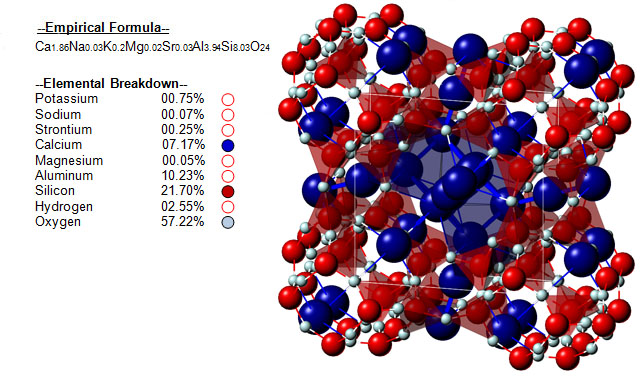

| Mineral Name | Chabazite |
| First Discovered | Prehistoric, Exact Year Unknown |
| Nickel-Strunz Classification | 09.GD.10 |
| Dana Classification | 77.01.02.01 |
| ICSD | Pre IMA |
| Mineral Group | Silicates - Tektosilicate within the zeolite group |


| Cleavage | Imperfect |
| Colour(s) | Colourless, green, Yellow, White, Pink, Brown, Orange |
| Specific Gravity | 2.09 |
| Diaphaneity | Transparent to Translucent |
| Fracture | Brittle, uneven - Very brittle fracture producing uneven fragments. |
| Mohs Hardness | 4.0 |
| Luminescence | Non-fluorescent |
| Luster | Vitreous (Glassy) |
| Streak | White |
| Habit(s) | Druse to Pseudo Cubic |
| Radioactivity | Chabazite per GRapi unit = 9.03 (%) |
| Magnetism | Non-magnetic |

The following health hazards should be noted when handling chabazite
 |
RADIOACTIVE Chabazite is radioactive as defined in section 49 CFR 173.403. Greater than 70 Bq / gram. |

The following image shows the elemental breakdown of the mineral chabazite along with the mineral crystal structure.


| Crystal System | Triclinic |  |
| Class | Pinacoidal | |
| Axial Ratios | a : b : c = 1.001 : 1 : 0.9957 | |
| Morphology | pseudorhombohedral crystals, tabular | |
| Optical Data Type | Biaxial (+/-) | |
| Pleochroism (x) | None | |
| Pleochroism (y) | None | |
| RL Values | nα = 1.478 - 1.487 nβ = 1.480 - 1.490 nγ = 1.480 - 1.493 | |
| Max Birefringence | δ = 0.002 - 0.006 (See colour chart at right) |  |
| Surface Relief | Moderate | |
| Dispersion | None | |
| Notes | If uniaxial, commonly shows birefringent panelling in six sections. | |

Chabazite can be referenced in certain current and historical texts under the following ten names:
The mineral chabazite can be translated into the following select languages:
| Arabic | Bulgarian | хабазит | Chinese (Sim) | 菱沸石 | |
| Croatian | Czech | chabazit | Danish | chabazit | |
| Dutch | Chabaziet | Esperanto | Ĥabazito | Estonian | |
| Finnish | Kabasiitti | French | chabasite | German | Chabasit |
| Greek | σαμπαζίτης | Hebrew | Hungarian | Chabazit | |
| Italian | Cabasite | Japanese | 菱沸石 | Korean | 캐버 자이 트 |
| Latin | Lithuanian | Norwegian | chabazitt | ||
| Persian | Polish | Chabazyt | Portuguese | ||
| Romanian | Russian | Шабазит | Slovak | Chabazit | |
| Spanish | Acadialita | Swedish | chabazit | Tagalog | |
| Turkish | sabazit | Ukrainian | шабазіт | Vietnamese |

Chabazite can be found in many places around the world. The map below shows major documented concentrations of chabazite:


 |
The MIROFOSS database offers free printable geological identification tags for personal and non-profit use. These tags can be used to properly identify mineral samples in your collection. -Click here- to download a full size jpeg image for a chabazite identification tag; which can be printed on paper or used with a plastic laser printer. |
 |
What's this? What can I do with it? |

| History | Neuhoff, P.S., J.F. Stebbins, & D.K. Bird (2003), Si-Al disorder and solid solutions in analcime, chabazite, and wairakite: American Mineralogist: 88: 410-423. |
| Chemical Composition | Zema, M.; Tarantino, S. C.; Montagna, G. (2008): Hydration/dehydration and cation migration processes at high temperature in zeolite chabazite. Chemistry of Materials 20, 5876-5887. |
| Geographical Data | Mindat.org. Retrieved on 2012-11-14 |
| Physical Identification | Webmineral.com. Retrieved on 2012-11-14 |
| Metaphysical Properties | Crystal Power, Crystal Healing: The Complete Handbook" by Michael Gienger |
| November 14, 2012 | The last time this page was updated |
| ©2017 MIROFOSS™ Foundation | |
 |